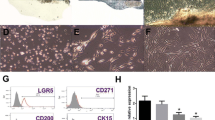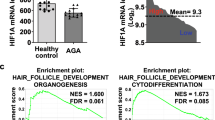Abstract
A previous study indicated that patients with androgenic alopecia (AGA) have significantly reduced levels of LncRNA RP11-818O24.3. This study investigates whether LncRNA RP11-818O24.3 promotes hair-follicle recovery and its possible mechanism. Hair alteration and cutaneous histopathological changes induced by testosterone propionate were observed by H&E and bromodeoxyuridinc (BrdU) stain to evaluate the therapeutic effect of LncRNA RP11-818O24.3 in C57BL/6 J mice. The cellular viability was analyzed in LncRNA RP11-818O24.3-transfected human hair-follicle stem cells (HFSCs) in vitro. The signaling pathways and pro-proliferative factors were investigated by transcriptomic gene sequencing and qRT-PCR. LncRNA RP11-818O24.3 transfection successfully recovered hair growth and hair-follicle cells in AGA mice. In a series of HFSC studies in vitro, LncRNA RP11-818O24.3 transfection greatly promoted cellular proliferation and decreased cellular apoptosis. Transcriptome gene sequencing suggested that the phosphatidylinositol 3-kinase (PI3K)-Akt pathway was upregulated by LncRNA RP11-818O24.3. The qRT-PCR results showed that fibroblast growth factor (FGF)-2 was 14-times upregulated after LncRNA RP11-818O24.3 transfection. Hair-follicle recovery activity of LncRNA RP11-818O24.3 may involve the upregulation of FGF2 and PI3K-Akt to promote follicle stem cell survival. These data not only provide a theoretical basis for AGA development but also reveal a novel therapeutic method for AGA patients.





Similar content being viewed by others
Data availability
The datasets generated and analyzed during the current study are available in Dryad repository. URL: https://datadryad.org/stash/share/P6kBKS0PY68Eu72bORWcoS-LxtMq2sKLjewHg5fYwy4https://doi.org/10.5061/dryad.k3j9kd5d7.
References
Adil A, Godwin M (2017) The effectiveness of treatments for androgenetic alopecia: a systematic review and meta-analysis. J Am Acad Dermatol 77:136-141.e135
Bao L, Yu A, Luo Y et al (2017) Genomewide differential expression profiling of long non-coding RNAs in androgenetic alopecia in a Chinese male population. J Eur Acad Dermatol Venereol 31:1360–1371
Bao L, Gong L, Guo M et al (2020a) Randomized trial of electrodynamic microneedle combined with 5% minoxidil topical solution for the treatment of Chinese male Androgenetic alopecia. J Cosmet Laser Ther 22:1–7
Bao L, Zong H, Fang S et al (2020b) Randomized trial of electrodynamic microneedling combined with 5% minoxidil topical solution for treating androgenetic alopecia in Chinese males and molecular mechanistic study of the involvement of the Wnt/beta-catenin signaling pathway. J Dermatolog Treat 33:1–11
Cai B, Zheng Y, Ma S et al (2018) Long noncoding RNA regulates hair follicle stem cell proliferation and differentiation through PI3K/AKT signal pathway. Mol Med Rep 17:5477–5483
Chen Y, Fan Z, Wang X et al (2020) PI3K/Akt signaling pathway is essential for de novo hair follicle regeneration. Stem Cell Res Ther 11:144
Choi SC, Kim SJ, Choi JH et al (2008) Fibroblast growth factor-2 and -4 promote the proliferation of bone marrow mesenchymal stem cells by the activation of the PI3K-Akt and ERK1/2 signaling pathways. Stem Cells Dev 17:725–736
Consortium SM-I (2014) A comprehensive assessment of RNA-seq accuracy, reproducibility and information content by the sequencing quality control consortium. Nat Biotechnol 32:903–914
Gentile P (2019) Autologous cellular method using micrografts of human adipose tissue derived follicle stem cells in androgenic alopecia. Int J Mol Sci 20:3446
Gong L, Xiao J, Li X et al (2020) IL-36alpha promoted wound induced hair follicle neogenesis via hair follicle stem/progenitor cell proliferation. Front Cell Dev Biol 8:627
Gupta AK, Mays RR, Dotzert MS et al (2018) Efficacy of non-surgical treatments for androgenetic alopecia: a systematic review and network meta-analysis. J Eur Acad Dermatol Venereol 32:2112–2125
He Q, Ren X, Chen J et al (2016) miR-16 targets fibroblast growth factor 2 to inhibit NPC cell proliferation and invasion via PI3K/AKT and MAPK signaling pathways. Oncotarget 7:3047–3058
Huang F, Gao TY, Wang WQ et al (2021) Engineered basic fibroblast growth factor-overexpressing human umbilical cord-derived mesenchymal stem cells improve the proliferation and neuronal differentiation of endogenous neural stem cells and functional recovery of spinal cord injury by activating the PI3K-Akt-GSK-3β signaling pathway. Stem Cell Res Ther 12:468–486
Kang JI, Choi YK, Koh YS et al (2020) Vanillic acid stimulates anagen signaling via the PI3K/Akt/ beta-catenin pathway in dermal papilla cells. Biomol Ther (seoul) 28:354–360
Kanti V, Messenger A, Dobos G et al (2018) Evidence-based (S3) guideline for the treatment of androgenetic alopecia in women and in men—short version. J Eur Acad Dermatol Venereol 32:11–22
Katzer T, Leite Junior A, Beck R et al (2019) Physiopathology and current treatments of androgenetic alopecia: Going beyond androgens and anti-androgens. Dermatol Ther 32:e13059
Kiso M, Hamazaki TS, Itoh M et al (2015) Synergistic effect of PDGF and FGF2 for cell proliferation and hair inductive activity in murine vibrissal dermal papilla in vitro. J Dermatol Sci 79:110–118
Kopp F, Mendell JT (2018) Functional classification and experimental dissection of long noncoding RNAs. Cell 172:393–407
Li J, Jiang TX, Chuong CM (2013) Many paths to alopecia via compromised regeneration of hair follicle stem cells. J Invest Dermatol 133:1450–1452
Lin BJ, Zhu JY, Ye J et al (2020) LncRNA-XIST promotes dermal papilla induced hair follicle regeneration by targeting miR-424 to activate hedgehog signaling. Cell Signal 72:109623
Lyu Y, Bai L, Qin C (2019) Long noncoding RNAs in neurodevelopment and Parkinson’s disease. Animal Model Exp Med 2:239–251
Park S, Erdogan S, Hwang D et al (2016) Bee venom promotes hair growth in association with inhibiting 5alpha-reductase expression. Biol Pharm Bull 39:1060–1068
Qiu W, Lei M, Zhou L et al (2017) Hair follicle stem cell proliferation, Akt and Wnt signaling activation in TPA-induced hair regeneration. Histochem Cell Biol 147:749–758
Rachinger N, Fischer S, Bohme I et al (2021) Loss of gene information: discrepancies between RNA sequencing, cDNA microarray, and qRT-PCR. Int J Mol Sci 22:9349
Rossi A, Anzalone A, Fortuna MC et al (2016) Multi-therapies in androgenetic alopecia: review and clinical experiences. Dermatol Ther 29:424–432
Shimabukuro Y, Terashima H, Takedachi M et al (2011) Fibroblast growth factor-2 stimulates directed migration of periodontal ligament cells via PI3K/AKT signaling and CD44/hyaluronan interaction. J Cell Physiol 226:809–821
Si Y, Bai J, Wu J et al (2018) LncRNA PlncRNA1 regulates proliferation and differentiation of hair follicle stem cells through TGFbeta1mediated Wnt/betacatenin signal pathway. Mol Med Rep 17:1191–1197
Takabayashi Y, Nambu M, Ishihara M et al (2016) Enhanced effect of fibroblast growth factor-2-containing dalteparin/protamine nanoparticles on hair growth. Clin Cosmet Investig Dermatol 9:127–134
Tang L, Liang Y, Xie H et al (2020) Long non-coding RNAs in cutaneous biology and proliferative skin diseases: advances and perspectives. Cell Prolif 53:e12698
Wang C, Gong B, Bushel PR et al (2014) The concordance between RNA-seq and microarray data depends on chemical treatment and transcript abundance. Nat Biotechnol 32:926–932
Wang X, Chen H, Tian R et al (2017) Macrophages induce AKT/beta-catenin-dependent Lgr5(+) stem cell activation and hair follicle regeneration through TNF. Nat Commun 8:14091
Yu AJ, Luo YJ, Xu XG et al (2018) A pilot split-scalp study of combined fractional radiofrequency microneedling and 5% topical minoxidil in treating male pattern hair loss. Clin Exp Dermatol 43:775–781
Yu CQ, Zhang H, Guo ME et al (2020) Combination therapy with topical minoxidil and nano-microneedle-assisted fibroblast growth factor for male androgenetic alopecia: a randomized controlled trial in Chinese patients. Chin Med J (engl) 134:851–853
Zhang Y, Xing Y, Guo H et al (2016) Immunohistochemical study of hair follicle stem cells in regenerated hair follicles induced by Wnt10b. Int J Med Sci 13:765–771
Zhang H, Su Y, Wang J et al (2019) Ginsenoside Rb1 promotes the growth of mink hair follicle via PI3K/AKT/GSK-3beta signaling pathway. Life Sci 229:210–218
Zhang X, Zhou D, Ma T et al (2020) Vascular endothelial growth factor protects CD200-rich and CD34-positive hair follicle stem cells against androgen-induced apoptosis through the phosphoinositide 3-Kinase/Akt pathway in patients with androgenic alopecia. Dermatol Surg 46:358–368
Zhu M, Kong D, Tian R et al (2020a) Platelet sonicates activate hair follicle stem cells and mediate enhanced hair follicle regeneration. J Cell Mol Med 24:1786–1794
Zhu N, Lin E, Zhang H et al (2020b) LncRNA H19 overexpression activates wnt signaling to maintain the hair follicle regeneration potential of dermal papilla cells. Front Genet 11:694
Acknowledgements
We are grateful to our colleagues in the Dermatology Department of the 2nd Clinical Medical College of Jinan University for their cooperation and support while performing this study.
Funding
This study was supported by the National Natural Science Foundation of China (No. 82203955) and the Science and Technology Innovation Committee Project of Shenzhen (No. JCYJ20220530152610023).
Author information
Authors and Affiliations
Contributions
LB and JZ contributed to the conception and the design of the study and also contributed to manuscript drafting. ZS, QZ and LD contributed to analysis and interpretation of the data. FY and LZ approved of the final manuscript version to be published. LB can confirm the authenticity of the raw data.
Corresponding authors
Ethics declarations
Conflict of interest
There are no competing financial interests to declare.
Ethics approval
Animal experiments were approved by the Ethical Committee of the Southern University of Science and Technology (No. SUSTech-JY202202026). We confirm that all methods were carried out in accordance with relevant guidelines and regulations. All methods are reported in accordance with the ARRIVE guidelines.
Patient consent for publication
Not applicable.
Additional information
Publisher's Note
Springer Nature remains neutral with regard to jurisdictional claims in published maps and institutional affiliations.
Supplementary Information
Below is the link to the electronic supplementary material.
Rights and permissions
Springer Nature or its licensor (e.g. a society or other partner) holds exclusive rights to this article under a publishing agreement with the author(s) or other rightsholder(s); author self-archiving of the accepted manuscript version of this article is solely governed by the terms of such publishing agreement and applicable law.
About this article
Cite this article
Bao, L., Sun, Z., Dang, L. et al. LncRNA RP11-818O24.3 promotes hair-follicle recovery via FGF2-PI3K/Akt signal pathway. Cytotechnology (2024). https://doi.org/10.1007/s10616-024-00624-3
Received:
Accepted:
Published:
DOI: https://doi.org/10.1007/s10616-024-00624-3




